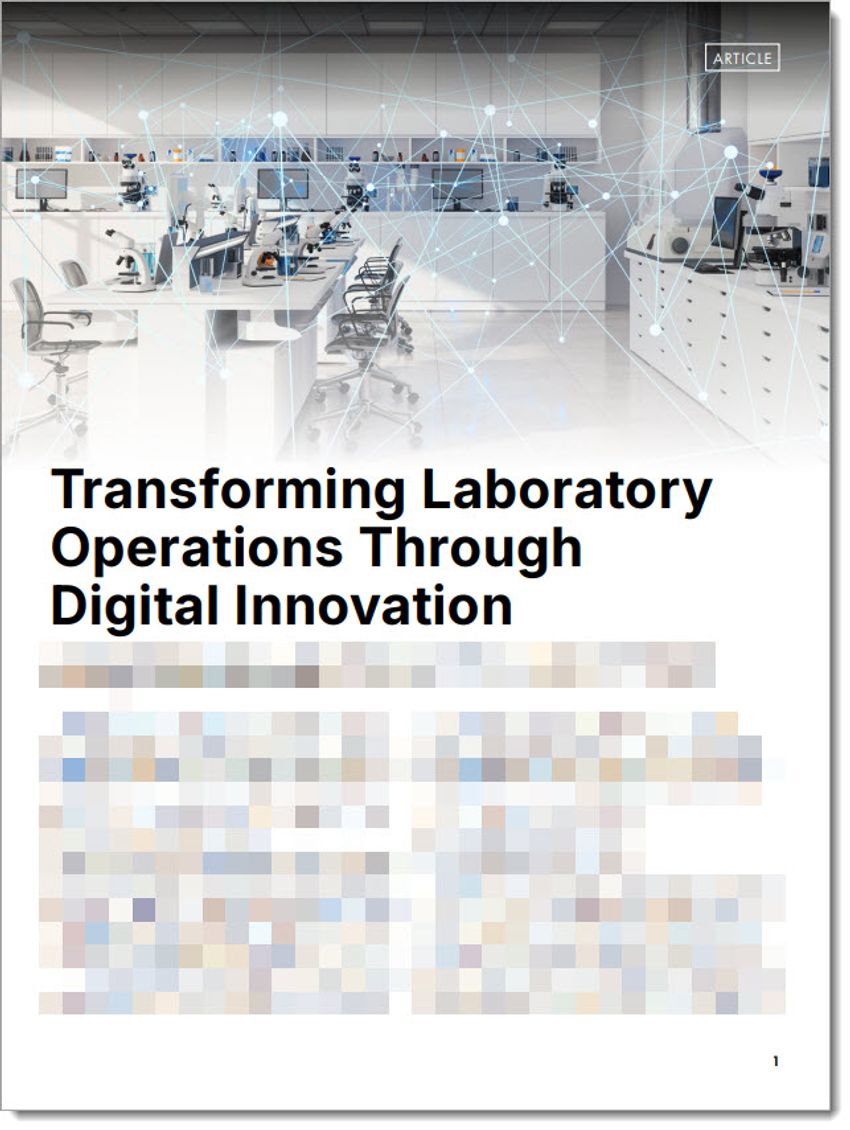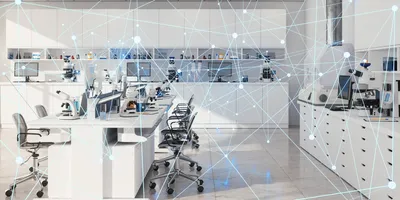Transforming Laboratory Operations Through Digital Innovation
Cloud computing, LIMS, and AI help labs improve efficiency, enhance accuracy, and drive innovation
In today’s rapidly evolving scientific landscape, digital transformation is essential for laboratories to remain competitive and efficient. This transformation goes beyond adopting new technologies, requiring a fundamental process, culture, and resource management shift. If these changes are achieved, they can foster a highly agile, data-driven laboratory environment.
Across industries, from clinical diagnostics to environmental testing, laboratories increasingly rely on digital solutions to manage growing volumes of data and overcome operational challenges. The rise of cloud computing, laboratory information management systems (LIMS), and artificial intelligence (AI) is equipping laboratories with powerful new tools to overcome traditional limitations and drive innovation.
The adoption of these technologies is not merely about automation; it’s about reimagining laboratory operations with a bottom-up approach. Digital strategies handle routine processes with accuracy and efficiency, enabling scientists and technicians to focus on higher-value tasks.
As laboratories face increasing pressure to rapidly deliver high-quality, low-cost results, digital transformation provides the tools to achieve excellence.
Current state and challenges
Despite recent technological advancements, many laboratories still operate with traditional and outdated infrastructure. This approach is characterized by paper-based documentation and manual data entry that consumes valuable staff time. Many facilities struggle with siloed, non-integrated systems, which create isolated data islands that make effective data analysis difficult. These disconnected systems
Key challenges
• Manual data recording and transcription
• Physical sample tracking and labeling
• Paper-based documentation and reporting
First steps
• Implement basic LIMS
• Electronic record keeping
• Introduce digital workflows
Benefits
• Reduced transcription errors
• Improved data accessibility
• Enhanced sample tracking
Features
• Centralized data storage
• Improved collaboration tools
• Enhanced security protocols
• Reduced IT infrastructure costs
• Improved system reliability
• Enhanced cross-team collaboration
Features
• AI-powered data analysis
• Predictive maintenance
• Automated quality control
• Predictive insights generation
• Proactive issue identification
• Automated routine decision-making
Key results
• Real-time operational intelligence
• Data-driven decision making
• Increased operational efficiency
• Enhanced quality and compliance
• Accelerated time-to-results
• Improved resource utilization
Digitally Transformed Laboratory
AI Integration
Cloud Adoption
Digital Transition
Paper-Based Laboratory
result in limited real-time visibility, making it almost impossible to identify bottlenecks or optimize workflows.
Likewise, inefficient data sharing and collaboration mechanisms can slow or even inhibit knowledge transfer and decision-making across teams and departments.
These traditional approaches generate challenges that reduce laboratory performance and capabilities. There is also an increased risk of human error during manual data entry and transcription, which compromises data integrity and experimental reproducibility. Decision-making processes are frequently delayed due to time-consuming data collection, compilation, and analytical procedures. Traditional approaches can also limit the identification of patterns and trends across large, complex datasets that span multiple instruments or studies. Regulatory compliance becomes more challenging when relying on paper-based documentation, particularly when attempting to maintain audit trails, chain of custody, traceability, and data security. Many laboratories also face resource constraints, with staff spending excessive time on administrative tasks rather than scientific discovery.
As testing volumes increase and expectations for rapid turnaround times become more common, these limitations become increasingly problematic. Digital transformation represents one of the most effective approaches to overcome these constraints, enabling laboratories to achieve more with existing resources while improving quality and compliance.
Key components of digital transformation
Successful digital transformation is built on several elements that work together to create a cohesive, efficient digital ecosystem. It starts with seamless data access and integration across all laboratory systems, from instruments to enterprise applications. This integration enables real-time visibility of laboratory operations and performance metrics, allowing managers to make proactive decisions rather than reacting to problems after they occur.
Advanced systems facilitate cross-functional collaboration capabilities, connecting scientists, technicians, and management for improved knowledge sharing and coordination. Importantly, modern digital transformation relies on future-ready platforms that support continuous innovation and growth as the organization evolves.
At the center of this digital ecosystem is the cloud-based LIMS, which acts as the central nervous system of a digital lab. Modern LIMS platforms have advanced far beyond basic sample tracking tools. They eliminate data silos through comprehensive integration with instruments, enterprise systems, and external partners, creating a unified information environment. These platforms standardize workflows and processes across laboratory operations, ensuring consistency and compliance regardless of the expertise or working style of the user. Advanced analytics capabilities and customizable dashboards enable truly data-driven decision making, transforming raw data into actionable insights. Additionally, modern LIMS platforms support regulatory compliance through automated documentation, audit trails, and electronic signatures, reducing the administrative burden while improving traceability.
The most successful digital transformation takes a phased approach, systematically addressing key operational challenges while building toward a comprehensive solution (Figure 1). This incremental strategy allows laboratories to reap rewards with limited disruption and risk. By initially focusing on the most critical operational challenges, laboratories can generate early wins that build momentum and support broader transformation efforts.
Innovation through technologies: Cloud, LIMS, and AI
The convergence of cloud computing, modern LIMS platforms, and AI creates a powerful foundation for laboratory digital transformation, with each technology playing a crucial and complementary role.
Cloud computing transforms laboratory operations through cost efficiency and scalability benefits (Figure 2). By eliminating the need for extensive on-premise IT infrastructure, which once in place imposes limitations on the organization’s ability to scale or evolve as laboratory technology changes, it provides the flexibility to adjust resources as needs change. Technology also offers improved accessibility and collaboration, enabling secure access from anywhere with internet connectivity, a particularly valuable feature in the current work environment. Cloud platforms typically provide enhanced security and disaster recovery protections, with dedicated security teams and redundant systems that often exceed what individual laboratories could implement independently.
Key payoffs
• Cloud software is easily updated
• The ability to adjust resources according to demand
• The option for future growth and expansion
• Tailored solutions for specific markets
Figure 2. Key payoffs of cloud systems.
Cloud-based LIMS serve as the foundation for data management across laboratory operations, consolidating information from diverse sources into a unified, accessible format. These platforms support machine learning model development and deployment, leveraging historical data to create predictive capabilities that enhance decision-making. Modern LIMS solutions also enable AI application integration, providing the structured data environment required to deliver meaningful results.
Within this cloud-based LIMS infrastructure, AI applications are revolutionizing laboratory practices in numerous ways. Automated data processing and validation reduce manual review time whilst improving data quality by applying consistent evaluation criteria. Pattern recognition algorithms enhance quality control by identifying subtle trends that might escape human detection across large datasets. Predictive maintenance capabilities monitor laboratory equipment performance and schedule interventions before failures occur, reducing downtime and extending equipment lifespan. Intelligent workflow optimization dynamically adjusts resource allocation based on real-time conditions, maximizing throughput while maintaining quality. Automated anomaly detection in test results flags potential issues for expert human review, ensuring that unusual findings receive appropriate attention while reducing false alarms.
It’s important to emphasize that AI should be viewed as a collaborative partner rather than a replacement for human expertise. The most successful implementations create a human–AI partnership where AI handles repetitive, time-consuming tasks that do not require contextual understanding. This approach frees laboratory professionals to focus on complex analysis, interpretation, and innovation. This combined human–AI approach enhances overall capabilities beyond what could be achieved independently, creating a relationship that maximizes both efficiency and scientific insight.
Strategic, cutting-edge approach to digital transformation
The Clinisys™ Laboratory Solution (CLS) exemplifies the cutting-edge approach to laboratory digital transformation, offering a cloud-based software as a service (SaaS) platform that supports activities across multiple industries in one platform with specialized capabilities for each sector’s unique requirements.
CLS provides industry-specific content packages for different laboratory disciplines, including pre-configured workflows, methods, and reports that accelerate implementation and adoption. The platform offers comprehensive support for essential laboratory processes across various sectors, from sample reception to result reporting, ensuring end-to-end process coverage. Built-in compliance tools address increasing regulatory requirements across global markets, helping laboratories maintain certification and accreditation with minimal additional effort to meet the latest standards. The platform’s seamless integration enables laboratories to incorporate emerging instrument and method-based technologies directly into their CLS workflows, ensuring they can adopt new analytical tools and techniques as they become available.
Clinisys brings extensive expertise in supporting digital transformation across diverse laboratory environments. This includes environmental and water quality laboratories, which benefit from specialized capabilities for managing complex regulatory requirements and reporting. Food and beverage safety testing facilities gain tools specifically designed for consumer protection and brand integrity. Toxicology laboratories receive features optimized for handling sensitive forensic and clinical testing with appropriate chain-of-custody protections. Public health organizations can leverage networking capabilities for coordinating multi-site disease surveillance networks and population health initiatives. Contract services testing providers gain functionality that help balance client needs with operational efficiency while maintaining appropriate data segregation.
The Clinisys partnership model distinguishes Clinisys as a strategic transformation partner, making them more than a simple laboratory technology vendor. This partnership model ensures that technology implementation aligns with organizational goals and delivers measurable operational improvements. By combining technology expertise with deep domain knowledge, Clinisys helps laboratories navigate the complexities of digital transformation while minimizing risks and maximizing returns on investment.
Backed by a global support network and a proven track record, Clinisys offers a full-service partnership, providing not just technology but a safe pair of hands to guide laboratories through every stage of digital transformation.
Conclusion
The integration of cloud computing, robust LIMS infrastructure, and AI capabilities represent the future of laboratory operations, creating intelligent, adaptable systems that enhance both efficiency and scientific excellence.
Laboratories embracing this digital transformation position themselves not only to overcome current challenges but also to establish the agility and intelligence needed for continuous innovation.
As scientific complexity increases and competitive pressures mount, the divide between digitally transformed laboratories and those clinging to traditional methods will only widen. Forward-thinking laboratory leaders recognize that digital transformation isn’t just about technology but about creating a foundation for scientific excellence and sustainable growth in an increasingly data-driven world. It is important to seek a LIMS that is not only modern but also relies on forward-thinking, cutting-edge technology.





